The White-Wing Doves of the Volcanoes

No these doves don’t live in volcanoes, but they are thriving around them, and I’m talking the Central American country of Nicaragua. Our party was making the shotguns roar not far from Granada – a town near the shores of Lake Nicaragua – that huge body of water that has some close relationship with the volcanoes – as does the lodge where we were staying – Mombacho – that lodge named for Mombacho Volcano that looks down on this place where we stayed.
Owned by Bruno Taino, he had enjoyed a long tenure in the province of Tamaulipas, Mexico handling bird hunters and fishermen for decades until the drug factions made it unsafe for any sportsmen to travel there. Bruno pulled up stakes and headed for Nicaragua. He has been putting hunters on white-winged doves there for six years, and in 2014 he opened Mombacho Lodge not far from Grenada. I shot there in April of 2016 and was back for more in January of 2017.
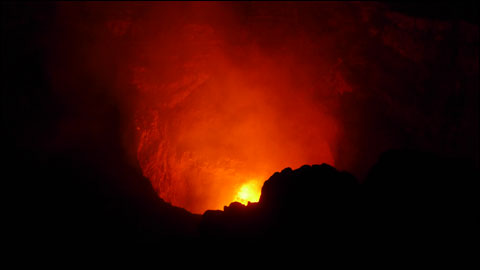
Our party of 10 was set up in a huge harvested sorghum field, and I remember looking down. Between my feet I noted how many of the sorghum seed heads the farmer had missed picking up. “There’s enough feed left here for zillions of doves – for months,” is what I was thinking.
But then bird boy Carlo woke me out of this mini reverie with “Right! Right!”
It took me too many mini seconds to locate the incoming doves he was talking about. I got the safety off and partially mounted the gun, but in that short time the white-wing flock was gone.
Not to worry because in less than 30 seconds Carlo was commanding, “Left! Left!”
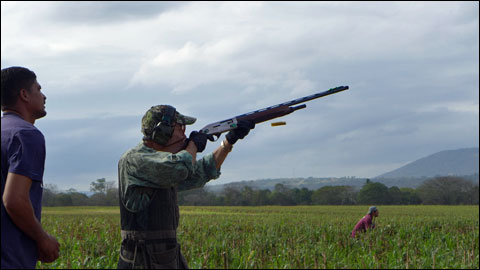
Ike Ikeguchi putting his semi-auto to work on a volcano white-wing.
While it was snowing back home in Pennsylvania I was in shirt sleeves in Nicaragua. A good breeze was blowing – keeping the bugs at bay and the white-wings flying like streaks. Soon another six birds were crossing on my right. I was only able to get one shot off (I missed), and then those doves started aerial maneuvers that would have put the Red Baron to shame.
I’ve shot at a lot of doves over the past many decades. Sometimes the shooting is close and relatively easy. But these white-wing accipiters with the long-pointed wings were giving me a lesson in shotgun comeuppance. Or maybe as my 80thbirthday is just around the corner I might not be the shooter I once was. Anyway, I was still out there and banging away, so I’m not ready for the so-called “couch” yet.
Just for perspective, a while ago in Uruguay Eduardo Gonzales poured a fresh box of shells into my pouch. I asked, “How many more boxes?” There were two more in the case, the fresh box just put in my pouch, and I had two in the over and under – so 77 shells. “Count my misses,” I instructed the young Eduardo. I missed one out of 77.
But here in Nicaragua white-wing shooting doesn’t pay to have your bird boy with a clicker counting the dead birds. That’s because at the end of a morning or afternoon of gunning shooters become depressed because their shooting percentage is taking such a miserable nosedive.
And did I mention the wind? The bug-scattering breeze was welcome – until hour after hour all I did was shoot behind so many of these doves that had the wind on their tail. The first shot was easier when the birds were flying into the wind, but at the sound of that first shot if there were six birds left they separated into six different directions – while squirting, doing rollovers, diving, zooming, chandelles, but mostly gaining one heck of a lot of speed.
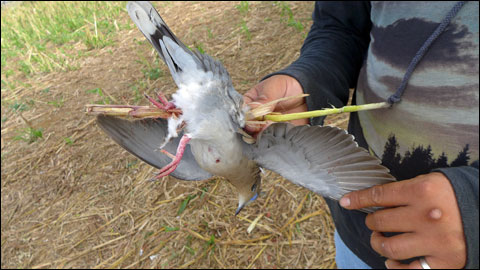
Obviously, this dove came down stone dead as its hard fall drove this sorghum stock right through its body. I have never seen anything like this in all my decades of dove shooting.
During these moments I yearned for my Perazzi MX8, but Bruno makes it easy to leave your favorite smoothbore at home because it costs $175 to bring one shotgun in and he does not charge for gun rental of his Benelli and Beretta semi-autos. That’s why my MX8 was back at home tucked in the gun safe. Still, not having a favorite shotgun in one’s hands is a good excuse when you’re missing more than you’re hitting with someone else’s gun.
Then there’s the keeping your head firmly on the stock mantra. This is never easy for some of us to do, though at the first shot I’m pretty good at this. But when the doves start their seemingly unreal gyrations I find my cheek-to-wood mantra falls by the wayside as it is so natural to want to see a bird better that’s performing those gyrations. For three days I scolded myself, “Keep your head tight you dope,” but I was largely unsuccessful.
The gun I was using was a Beretta A300 Outlander – a 12 gauge with an Improved Cylinder screw in – certainly a good enough gun, but it wasn’t a Perazzi. When I missed with the semi I scolded the gun, looked down at it with disdain, but it wasn’t the gun that was at fault.
There were too many times to count when I had one of those Volcano white-wings dead to rights. But just as I pulled the trigger the dove would juke right, left, dive or zoom upward. How do they know?
One morning we bounced up a dirt path for a good 15 minutes. There was no one around. We were headed to a ridge where there was no sorghum or other food. We were simply trying to intercept the birds as they flew from roost to chow. But by the time the first shot bellowed the local folks were congregating behind us. I wondered, “Where did they come from?” There wasn’t an abode within shotgun-blast distance.
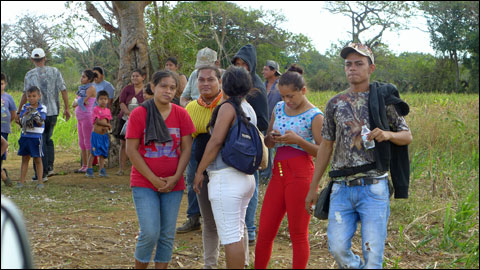
The locals come out of the figurative woodwork for their share of the doves. As you can see they do not come attired in camo. Also, not a bird goes to waste. The local folks want them all.
Groups of locals arriving on the shooting scene is not uncommon in Argentina, Bolivia or Uruguay, but Nicaragua takes the figurative cake for gun blasts bringing out the locals? Why? My guess is that protein is a hard commodity to come by with these poor folks. They come for the doves. Consequently, you should have no compunctions about shooting these birds. Not a one goes to waste. They retrieve every bird that lands in a tough-to-get-to place, too. They wear broad smiles.
The shotgunners always come in camo or drab clothing, but it is almost a waste to do that. The bird boys are attired in bright shirts, little if any camo, and the locals are dressed in calico tones. This attire no doubt spooks many a dove, but there’s nothing one can do about this but keep on shooting.
Generally, morning hunts don’t last quite as long as the afternoon hunts. Wake up around 5:00 am. Have breakfast. Leave shortly thereafter. You are back well before noon – shortly it is lunchtime – leave immediately afterwards – back from the afternoon hunt maybe 5:00 – 6:00 pm. Did I mention the margaritas? Of course, any drink is on the house.
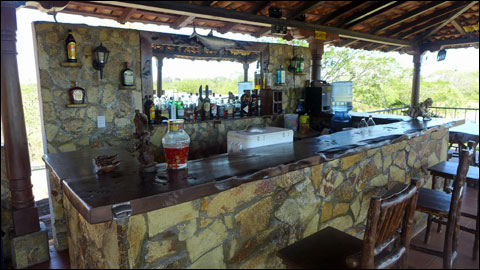
At Mombacho Lodge the drinks are on the house.
If you travel to any dove shooting destination think about shooting the birds while they are still well in front (assuming incomers). There’s a tendency (myself included) to hold off until the bird(s) is closer. Just a bit of hesitation and you have a crossing shot. Not a bad thing, but the closer the dove is to you the more inclined the bird is to start its aerobatic tactics. Usually not a good thing for shooting percentage improvement. If you miss that incomer when it is well in front that gives you more time to give him your second load.
Watching that incomer while you’re shouldering the gun, then waiting and waiting until the sight picture looks perfect is likely to put the shooter behind the figurative 8-ball. The great English wing gunner Lord Ripon advised instead, “Don’t check.” He means raise the gun and shoot without delay. I’ve written this before and add to the Lord’s suggestion, “Cheek but don’t check.” Which advises to get the head tight to the stock – then bang away immediately.
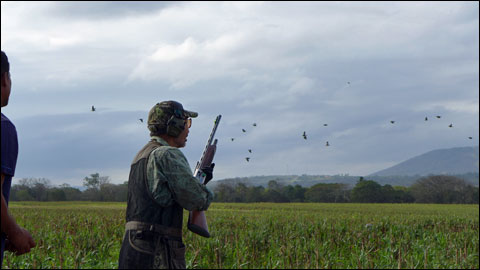
Ike Ikeguchi getting ready to go to work on the volcano whitewings. The right background – probably another volcanic mountain.
Getting back to this “head-on-the-stock” thing. Sometimes I find myself with my head on the stock, but I’m not buried in – like I would be on a High Two skeet target or say a dropping sporting clays incomer. My cheek might be touching the wood but my head is so high trying to see the bird better that too much rib is showing – another factor that contributes to a miserable shooting percentage.
As interesting as it is to see so many volcanoes, some in perfect volcanic cone shape, others with huge parts of their lids no longer intact, it is the white-wings that attract we smoothbore aficionados. The birds’ aerobatic antics that result in very difficult shooting keep many of us coming back.
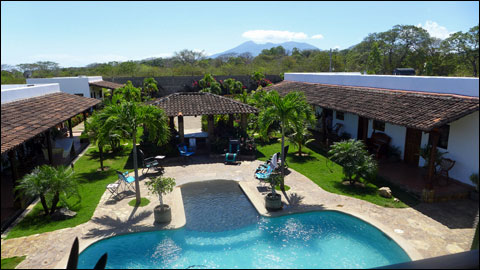
Looking out from the second deck at Mombacho Lodge.
The swimming pool is easily apparent, but that’s Mombacho Volcano in the background. As you can see, this volcano blew its top off, but that was thousands and thousands of years ago.
You’ll bag more doves (the eared dove, however) in Bolivia, Uruguay and Argentina, but Nicaragua is definitely closer – less than a three-hour flight out of Houston or Miami. Plus you’ll still get your fill of shooting – and margaritas. Mombacho Lodge has trips of three full days of shooting and trips of two full days and two half days. Bookings can be made through Trek Safaris.
The lodge takes up to about 10 shooters – mostly in single room accommodations. There’s a pool. The vehicles were found very good. One fellow in our group shot 99 boxes in three days – so the shooting is there.
Nick welcomes your emails at nicksisley@hotmail.com. Sisley has been writing full time for 43 years, his thousands of articles appearing in many, many magazines. He’s the author of eight books, is an NSCA, NSSA and NRA Shotgun Instructor and a pilot with many ratings.
Useful resources:
About Mombacho Lodge on the Trek Safaris web site

Nick Sisley welcomes your emails at nicksisley@hotmail.com. Sisley has been writing full time for 43 years, his thousands of articles appearing in many, many magazines. He’s the author of eight books, is an NSCA, NSSA and NRA Shotgun Instructor and a pilot with many ratings.


Comments